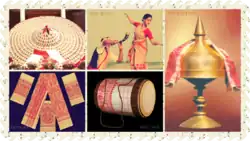Bathouism
Bathouism (बाथौ) is the ethnic religion of the Bodo people or Kachari people. The name Bathou (Ba=five; thou=deep)[4] in Bodo means five principles.[5] The five principles are: bar (air), orr (fire), ha (earth), dwi (water) and okhrang (ether).[6] The chief deity, called Bathoubwrai (bwarai: "the Elder")—omnipresent, omniscient and omnipotent—is said to have created the five principles. Though there are other minor gods and goddesses, Bathoubwrai is considered the Supreme God. Bathoubwrai is unseen. The second most important deity is Mainao, the consort of Bathoubwrai, who is considered as the "protector of the rice fields".[7]

| Part of a series on the |
| Culture of Assam |
|---|
 |
It is reported that Bathouism will be included in the Indian census.[8]
Sijou plant
The sijou plant, a woody species of (Euphorbia)[9] is considered the living embodiment of Bathoubwrai. Families that follow Bathouism plant a sijou shrub at the northeast corner of their courtyard, in an altar called sijousali. Bodo communities that follow Bathouism generally plant a sijou shrub at a community land, fenced with eighteen pairs of bamboo strips with five fastenings.[10] Each pair symbolizes a pair of minor god-goddess. The five fastenings signify, from bottom: birth, pain, death, marriage and peace/pleasure. The bottom three fastenings, called bando, are those that one cannot escape in life; whereas the top two one could.
Gods, goddesses and gurus
(Endle 1911) differentiates between household gods and community gods. Of the household gods Bathoubwrai, Mainao, Song Bwrai/Burai and Bura Bagh Raja are considered prominent.[11] The practice of representing Bathoubwrai by the sijou tree was more common among Boros(or Mech) of Goalpara region, and less so in Darrang. Song Raja is usually represented inside the house in an altar called dham, a deity who obtains devotion from women, and receives offerings during women's menses; but these offerings are eventually brought out and laid at the sijou tree representing Bathou.[12]
The eighteen pairs of gods-goddesses are: 1 Mwnsinsin bwrai-Mwnsinsin burwi, 2 Si Bwrai-Si Burwi, 3 Aham Bwrai-Aham Burwi, 4 Khuria Bwrai-Khuria Burwi, 5 Eheo Bwrai-Eheo Burwi 6 Mainao Bwrai-Mainao-Burwi, 7 Bwlli Bwrai-Bwlli Burwi, 8 Deva Bwrai-Devi Burwi, 9 Gongar Bwrai-Gongar Burwi, 10 Joumwn Bwrai-Joumwn Burwi, 11 Song Raja-Song Rani, 12 Hasung Bwrai-Hasung Burwi, 13 Rajong Bwrai-Rajong burwi, 14 Agrang Bwrai-Agrang Burwi, 15 Hazw Bwrai-Hazw Burwi, 16. Emao Bwrai-Emao Burwi 17. Mohela Bwrai-Mohela Burwi and 18. Hafao Bwrai-Hafao Burwi.
Worship
Traditional
Traditional Bathouism did not have any written scripture or religious book, nor temples. The worship is performed at the sijousali, and constituted offering animals and fowls for sacrifice and rice beer. Notable religious festivals were Kherai, Garja and others. These ceremonies are performed by priests called Douri (male priest) and Doudini (female priest). This religion was not organized.
Revivalism/Reformation
All Bathou Religious Union, an organization, was constituted in 1992; and it has begun reviving and reforming the traditional religion. The traditional role of the Douri and Doudini are replaced by the Gwthari Asari appointed by the organization, and a band of singers who sing in a practice called Bathou Aroj. The construction of temples, resembling churches or mosques called Thansali, have come into being. Bathou aroj is performed on Tuesdays in Thansalis. Sacrifices of animals and fowls, and offering of rice beer as modes of worship has been replaced by offering of flowers, fruits and the burning of incense. The partaking of prasad has also become popular.
Notes
- "639 Identifier Documentation: aho – ISO 639-3". SIL International (formerly known as the Summer Institute of Linguistics). SIL International. Retrieved 29 June 2019.
Ahom [aho]
- "Population by Religious Communities". Census India – 2001. Ministry of Home Affairs, Government of India. Retrieved 1 July 2019.
Census Data Finder/C Series/Population by Religious Communities
- "Population by religion community – 2011". Census of India, 2011. The Registrar General & Census Commissioner, India. Archived from the original on 25 August 2015.
- (Boro 2014:28)
- "The meaning of the term ‘Bathou ’ is five deep principle of creation." (Boro 2014:2)
- "...five ingredients of earth, water, air, fire and ether {ha, dwi, bar, or and okhrang). (Boro 2014:3)
- (Endle 1911, p. 37)
- (Inside NE & 2019-02-06)
- "The Bathouism or Bathou is symbolised by the Sijou plant (Boro 2014:3)
- (Boro 2014:43)
- (Endle 1911, pp. 35–36)
- (Endle 1911, pp. 36–37)
References
- Boro, Anil (2014). Bathou religion and its impact on boro society a folkloristic study (PhD). Retrieved 1 February 2019.
- Endle, Sidney (1911). The Kacharis. London: Macmillan and Co. Retrieved 20 February 2013.
- Inside NE (6 February 2019). "Indian Census shall now recognize 'Bathouism' officially". Archived from the original on 6 February 2019. Retrieved 6 February 2019.